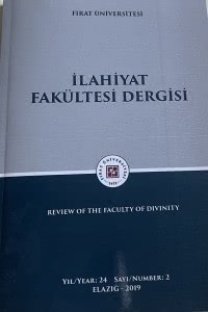Asr-ı Saadet ve Önceki Dönemlerde Medya ve İletişim
İslam Tarihi, , Medya, , Medya Organları, , İletişim, , İletişim organları
Media and Communication in Age of Bliss and Previous Periods
Islamic History, Media, Media Organs, Communication, Communication Methods,
___
- Abdülhalim, Muhiddin. el-İ‘lâmü’l-İslāmī ve Tatbikātihi’l-‘Ameliyye. Kahire: Mektebetü’l-Hancî, 1979.
- Afgânî, Saîd el-. Esvāku’l-‘Arab fī’l-Cahiliyyeti, Dımeşk: y.y. 1993.
- Ali, Said İsmail. Temhîd li-Tārīḫi’Terbiyeti’l-İslāmiyye. Kahire: ‘Alemü’Kütüb, 2010.
- Birunî, Ebu’r-Reyhân Muhammed b. Ahmed el-. el-Āsaru’l-Bākıye. Kahire: Dâru’n-Neşri’l’-‘Arabî, 2007.
- Breasted, James. Echizetü’l-İ‘lām ve Tenmiyetü’l-Vataniyye. Kahire: Mektebetü’l-‘Arabiyye, ts.
- Câhız, Ebu Osman Amr b. Mahbûb. et-Tāc fī Ahkākı’l-Mülûk. thk. Hamed Zeki Paşa. Kahire: Dâru’l-Fikri’l-‘Arabî, 1965.
- Cevzî, Şemseddin Ebi Abdullah Muhammed b. Ebi Bekir b. Eyyub İbn Kayyım el-. Zadü’l Meād fī Hedyi Ḫayri’l-‘İbād. Beyrut: Müessesetü’r-Risâle, 2009, 1/62.
- Derveze, Muhammed İzzet. Siyretü’r-Rasûl. Kahire: Matbaatü’l-İstikâmet, 1948, 1/39.
- Ebi Yakub, Ahmed b. Tārīḫu Yakubī. Necef: Matbaatü’l-Ğar’î, 1/304.
- Emin, Ahmed. Fecru’l-İslām. Kahire: Müessesetü Hindâvî, 2012.
- Hafecî, Muhammed. el-Hayātü’l-Edebiyye. İskenderiye: Dâru’l-Vefâ, ts.
- Hamîdullâh, Muhammed. el-Vesāik. Beyrut: Dâru’n-Nefâis, 1987.
- Hamza, Abdüllatif. el-İ‘lām lehu Tārīḫuhu ve Mezāhibubu. Kahire: el-Heyetü’l Mısrıyyeti’l-Amme li’l-Kitâb, 2002.
- Hamza, Abdüllatif. el-İ‘lām fī Sadri’l-İslām. Kahire: Dâru’l-Fikri’l-‘Arabî, 2007.
- Hamza, Abdüllatif. el-İ‘lām ve Mezāhibuhu. Kahire: Dâru’l-Fikri’l-‘Arabî, 1965.
- Harun, Abdüsselam. Tehzibü Siyer-i İbn Hişām. 14. Baskı, Kahire: Dâru Buhûsu’ş-Şâmile, 14. Basım, 1985.
- Hatem, Muhammed Abdülkadir. Re’yü’l-‘Amm ve Te’siruhu bi-İ‘lām ve’d-Diy‘āye. Beyrut: Mektebetü Lübnân, 2006.
- Innıs, Harold. İmparatorluk ve İletişim Araçları. çev. Nurcan Töreli, Ankara: Ütopya Yayınevi, 2006.
- İbn Kesir, Ebu’l-Fidâ İmâdüddin İsmâil b. Şihâbeddin Ömer. el-Bidāye ve’n-Nihāye. Beyrut: Mektebetü’Ma‘arif, 1990, 2/306.
- İbn S’ad, Muhammed b. Menî el-Hâşimî el-Basrî. Tabakātü’l-Kübrā. Beyrut: Dâru Sâdır, 1957, 1/260, 4/189.
- İmam, Abdülhalim. el-İ‘lām ve’l-İttisāl bi’l-Cemāhîr. Beyrut: Mektebetü’n-Nûr, ts.
- İbn Hişâm, Ebu Muhammed Cemâlüddin Abdülmelik b. Hişâm b. Eyyûb el-Himyerî. Siyretü’n-Nebeviyye. thk. Mustafa es-Sakâ vd. Beyrut: Dâru’l-Kalem, 1990, 2/93.
- Hayrettin Karaman vd. Kur’ân-ı Kerîm Meāli. Ankara: Diyanet Vakfı Yayınları, 2009.
- Kurban, Melham. Kadāya’l-Fikri’s-Siyāsī. Beyrut: el-Müessesetü’l-Câmi‘yyetü li’d-Dirâseti ve’n-Neşr, 1992.
- Mahcûb, Teysîr el-Fitnânî. Mukāvvematü Racüli’i-‘İ‘lām. Amman: Dâru ‘Umrân, y.y., 1987.
- Nasr, Ömer en-. Kıssatü’l-‘Arab Kable’l-İslām. Beyrut: Dâru Mektebu Ömer Ebu’n-Nasr, 1970.
- Nevfel, Ebu’l-Mecd Seyyid. ed-Da‘vetü ila’lāllah. Medine-i Münevvere: Mecelletü’l-Câmi‘ati’l-İslâmiyye, 2017.
- Powers, Fubon. el-Mesraḥ fī’ş-Şark. çev. Ahmed Rıza, Muhammed Rıza, Kahire: Dâru’l-Kütübü’l-‘Arabiyye, ts.
- Sher, Edy. Tāc Keld ve Asur. Beyrut: Matba‘atü Katolikiyye, 1913.
- Şahin, Semay Buket. Medya Teknolojileri Kapsamında Medya Arkeolojisi Üzerine Bir İnceleme. İstanbul: Marmara Üniversitesi, Sosyal Bilimler Enstitüsü, Yüksek Lisans Tezi 2019.
- Taberî, Ebu Cafer Muhammed b. Cerîr et-. Tārīḫu-Taberî. thk. Muhammed Ebu’l-Fazl İbrahim, Kahire: Dâru’l-Maarif, ts, 1/47-48.
- Zamahşerî, Mahmud. B. Ömer b. Muhammed el-Haverzimî el-. Kitābu’l-Mufassal. thk. Fahri Salih Kadâre, Amman: Dâru ‘Umrân, 2004, 6/406.
- Zehebî, İmam Şemseddin Muhammed b. Ahmed b. Osman ez-. A‘lāmü’n-Nübelā. Beyrut: Müessesetü’r-Risâle, 1996, 2/8.
- Zeydan, Corci. el-‘Arab Kable’l-İslām, Kahire: Matba‘atü Hilâl, 1922.
- ISSN: 1304-639X
- Yayın Aralığı: 2
- Başlangıç: 1996
- Yayıncı: FIRAT ÜNİVERSİTESİ İLAHİYAT FAKÜLTESİ
Ma‘rûf el-Kerhî'nin Sûfî Şahsiyeti ve Tasavvufun Menşeindeki Rolü
Arapça Sözlükler ve Kurân-ı Kerîm Işığında Hamd-Şükür Kavramları ve Aralarındaki İlişki
Tefsir ve Tasavvuf Kaynaklarında Vahyin Keyfiyeti ve Devamlılığı Hususundaki Tartışmalar
Ahmet KÜÇÜK, Mohammd Ajmal HANİF
Abbâsî Devleti Kâtiplerinin Kullandığı Yazı Araç-Gereçleri
Fransa Katolik Kilisesi’nde Gallikanizm
Vahyin Dilini Vahiyle Özdeşleştirme Çabalarına Din Felsefesi Bağlamında Eleştirel Bir Değerlendirme
Covid 19 Pandemi Döneminde Dini Başa Çıkma Tarzları İle Ruh Sağlığı Arasındaki İlişkinin İncelenmesi
Dil ve Üslûp Özelliklerinin Ayetleri Anlama Etkisi Üzerine Bir İnceleme
